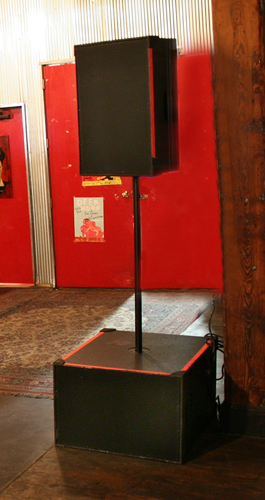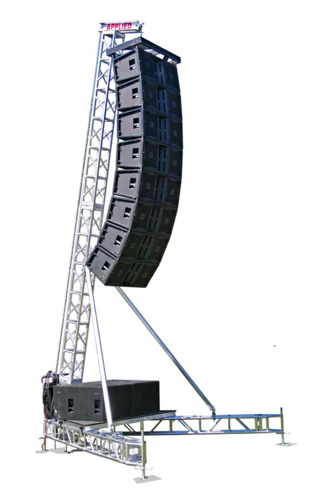
Stands. Tripod stands are commonly employed for loudspeakers at smaller shows. While very safe, the tripod legs should be extended to their largest footprint when possible so they provide maximum stability for the stand. Make sure the top of the stand is correctly sized for the loudspeaker socket or the cabinet could tilt and its center of gravity will not be directly over the pole.
Also, position the stand where the tripod legs will not be a trip hazard as a fall could cause a person injury, as well as possibly knock over the stand (and loudspeaker).
Use fixed leg tripod stands only on level ground. Saddle style sandbags can be used with tripod stands to add a bit of weight to the bottom for increased stability. The sandbag should straddle the leg, not hang from any bracing. To avoid crew injury, larger loudspeakers should be hoisted onto stands by two people.
Truss Totem. Particularly popular on corporate gigs, truss sections are bolted to bases and used in an upright position for lighting trees, projector and delay speaker stands. Totems can be very top heavy so additional weight, usually sandbags, are placed on the base to help with stability.
When used with a single loudspeaker on the top, make sure that the cabinet’s center of gravity is located directly over the center of the truss. When used with a column-type loudspeaker attached to the side of the truss, make sure that additional weight is placed on the base on the opposite side to offset any leaning tendency caused by the side loading of the loudspeaker. Totems should only be used on level ground. If used outdoors, these systems need to be guyed down.
Pole Mounted On Sub. Pole mounting a loudspeaker on a subwoofer provides a clean and easy setup for many gigs. It allows the top cabinet to be raised to a good operating height while eliminating the tripod base that may become a trip hazard. Some systems allow for the use of two poles for larger top cabinets or line array-style boxes. To avoid problems, use only the manufacturer’s recommended poles with these systems, as different poles may not be compatible or as stable as the factory units.
Crank Towers. These come in many forms from larger versions of tripods to heavy-duty units that can hold 600-plus pounds. Crank towers are becoming a popular option to fly a smaller array without having to use motors. Make sure that all outriggers and legs are extended and the tower is leveled correctly before raising the load. Factor in the rigging hardware weight and speaker cable weight when figuring out the total weight you will be lifting. Check with the manufacturer before using the lift outdoors and follow their recommendations on using the system outside.
Pair Of Towers & Truss. This is a common setup at medium-sized shows and corporates that utilizes a pair of crank towers and a span of truss that goes across the front of the stage. The truss usually does double duty and supports some front stage wash lights as well as the loudspeakers. It can give the ability to provide a small left, center and right array without requiring any ceiling points.
Care should be taken to not overload the systems, because total working load on horizontal truss is based on an evenly distributed load. Also take into consideration the weight of the loudspeaker and lighting cables when figuring out the total weight of the system. This type of setup is considered a system and needs to be designed by a qualified rigger.
Line Array Tower Truss. A relatively new option for positioning loudspeakers is the line array tower. Made from truss sections and specialty hardware fittings, these systems can be disassembled for transport or storage and easily bolted together on the job site to support a wide variety of speaker arrays.
Smaller towers may use a manual hoist to lift the array, while larger units utilize a powered hoist. Make sure the tower is leveled correctly before use. When deployed outdoors, the tower must be guyed down per the manufacturer’s recommendation. Some tower systems allow placing subwoofers on top of the forward outrigger legs so they can act as additional ballast.
Dead Hang Flown. Dead hang means that an item is connected to a support structure without a motor or lift system. The attachment point can be an exposed ceiling beam, tent pole, section of truss, etc. An engineer should be called in to certify the weight loading ability of any ceiling point before use if it is not known.
Only competent or qualified riggers should dead hang cabinets as each hanging point needs to be individually assessed by a person with knowledge and experience to determine what hardware is required to safely support and position the loudspeakers.
Access to dead hang points may involve a personnel lift. Make sure fall protection systems are used by anybody in the lift and that the systems are inspected before use. A spotter may be required to assist the lift operator as many types of equipment have blind spots.
Air Wall Tracks. Air walls are the movable walls in large meeting spaces and ballrooms. These tracks are often utilized as ceiling points for video screens, lighting and audio delay speakers when they are not being used by the wall sections. While technically considered a dead hang, air walls pose a few specific challenges to production crews. All air walls are not the same, and each requires specific fittings dedicated for that track style.
There are also a few universal type air wall hangers that will fit a wide variety of common track styles—but they don’t fit all. Be sure to use the correct fitting or hanger for the track because some models may seem to fit into the wrong tracks, but they’re not providing the correct support. Air walls have limited weight bearing capacity per point, so it’s critical not to overload any point on the track. Because of their limited single point capacities, air walls are commonly limited to flying lightweight objects, or used as cable supports.
A building’s engineering department should be able to tell you how much weight and at what intervals you can fly from the track. One important thing to consider is whether the room needs to be reconfigured and the walls moved during or immediately after the event. If the walls need the tracks, nothing else can be installed on them.
Unistrut Tracks. It’s very common for convention centers and newer hotel ballrooms to have Unistrut tracks installed in ceilings and sometimes even walls. Like air walls, they require a specific connector to be safely used. Different sized tracks have different safe working loads. Again, a building’s engineering department should be able to tell you the weight limits and spacing required for utilizing the tracks.
Motors. They can be used singly to hoist individual loudspeakers and small arrays, and in multiples to hoist larger arrays. A motor attached to the rear of an array can be used to help tilt and aim the array. Only competent or qualified persons should perform any rigging with motors.
Before use, check the motor hooks and inspect the chain for any signs of damage. Make sure the chain bag is attached correctly and is in good shape. Before any motor is operated, the rigger needs to make sure that everybody on the deck is aware that something will be moving. Before an array or truss is lifted, one competent person should double check all rigging hardware and fittings.
Construction Lifts. They’re sometimes used to elevate or fly loudspeakers at festivals. Scissor lifts are popular when small horizontal arrays need to be raised, moved or relocated at events like airshows. Larger festivals might utilize construction cranes or large extendable boom forklifts to fly the main PA system.
Make sure the equipment operators are certified on that model unit, and that an operator is monitoring the equipment continuously during use. Weight loading changes depending on the angle of the boom so it’s vital to no overload the equipment during use. Tag lines should be used to keep an array from swinging in the wind. An engineer should determine the maximum wind speeds the systems can operate in, and if the wind reaches that limit, the PA should be lowered immediately to the ground.
Remember, safety is the most important thing. Rigging is dangerous, but using the proper equipment and procedures, skilled people can overcome gravity, one loudspeaker at a time.
In addition to being the owner of Las Vegas-based production company Tech Works, Craig Leerman is also a U.S. Navy trained and certified rigger.


